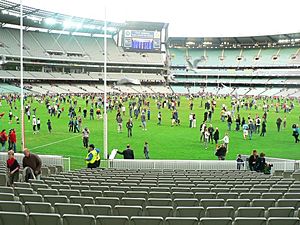Kick-to-kick facts for kids
Kick-to-kick is a fun activity and a popular tradition for fans of Australian rules football. It's an Australian term for games where you kick a ball and someone else catches it. Think of it as a casual, relaxed way to play Australian rules football. It's a bit like playing backyard cricket compared to a professional cricket match.
Even though it's not an official sport, kick-to-kick is a social game. You can play it in parks, fields, streets, or even your backyard. You only need at least two people to play. Many Australian rules football clubs use kick-to-kick as a warm-up. It has also helped start new clubs in many different places. For a long time, it was common for fans to run onto the field for kick-to-kick after professional matches. However, this tradition has mostly stopped at major AFL stadiums today.
Contents
How to Play Informal Kick-to-Kick
In a simple game of kick-to-kick, two players stand about 15 metres or more apart. They take turns kicking the ball to each other. The other player tries to catch the ball, which is called a mark. Players might run or bounce the ball before kicking it. They also try different kicking styles, like the drop punt or torpedo punt.
If there are goal posts nearby, players often practice scoring goals. Kick-to-kick is a popular family activity. Many famous footballers learned their skills playing kick-to-kick in their backyards. Some people even think that playing informal kick-to-kick can help kids stay healthy and active.
Fun Variations of Kick-to-Kick
Sometimes, kick-to-kick can involve more players. They usually group up at each end of the playing area. This makes it easier to get the ball back. These games can include some friendly competition. Many Australian rules fans enjoy trying to do a "stepladder" mark. This is when one player jumps on another's back to take a spectacular high catch, known as a specky. You might hear them shout names like Jesaulenko or Capper, who were famous for these amazing marks.
Where Did Kick-to-Kick Come From?
Some people believe the ancient Indigenous Australian game of Marn Grook might have influenced Australian rules football. Marn Grook involved kicking a ball, and it shares some similarities with modern kick-to-kick.
An author named Sean Fagan suggests that the kick-to-kick tradition might have started with rugby football in England. He found old books from 1856 that mention "punt about." These books talk about kicking practice, but they don't clearly say if other players were catching the ball and kicking it back.
Kick-to-Kick in Other Sports
Fans and players of Rugby union and rugby league don't usually play kick-to-kick as much as Australian rules football fans. This is because kicking is a very specialized skill in those sports. Also, there are other small-scale versions of rugby, like touch football. Fans of Gaelic football and association football (soccer) also play similar kick-and-catch games with a round ball.
Sometimes, Australian rules fans use "kick to kick football" as a way to describe a boring game. This happens when professional AFL matches have too much uncontested play. They compare it to non-contact sports like basketball or netball. This is because regular kick-to-kick doesn't usually involve the tackling, bumping, or spoiling you see in a real game. These actions make a game more exciting and unpredictable.
Kick-to-Kick in Pop Culture
- In 1990, artist Michael Leunig painted a picture called "Street Football."
- A short film named "Kick to Kick" was made by Tony McNamara in 2000.
- In 2007, Auskick, a program for young footballers, used the kick-to-kick tradition in their TV ads. The ads showed kids all over Australia kicking the football to each other.


